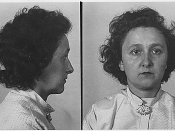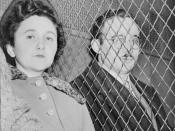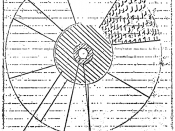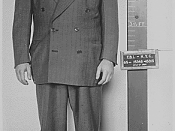On June 19, 1953, Julius and Ethel Rosenberg were put to death by electrocution at Sing Sing Prison in Ossining, New York. The Rosenbergs were tried and convicted of conspiracy to commit espionage (Fariello 178). The Rosenbergs were accused of selling atomic secrets to the Soviet Union as a part of a large spy ring. The presiding judge over the trial, Judge Irving R. Kaufman, handed down the sentence on April 5, 1951 (Wexley 597). There has been much controversy surrounding the guilt or innocence of Julius Rosenberg and his wife, Ethel. As more documents have been released concerning the Rosenberg case, Julius Rosenberg's guilt as a spy has been established. Ethel Rosenberg was almost certainly an accomplice to her husband's crimes even though the government's case against her was weak (Radosh 448). The severity of the punishment, however, was too great for the crime committed by the Rosenbergs.
Julius and Ethel Rosenberg were tried, convicted, and sentenced in an era when communism was feared, Russia was an enemy, and scapegoats were needed to blame for foreign conflict. Justice requires that the punishment fit the crime; however, at times the punishment fits the environment. At a time when anti-Communist sentiments ran high, the Rosenberg's sentence of death by electrocution was too severe for the crimes that they committed.
Julius and Ethel Rosenberg were accused of conspiracy to commit espionage. Prosecutors usually use the conspiracy charge when there is a lack of evidence to prove the actual commission of a crime (Wexley 277). Julius Rosenberg was arrested and charged with recruiting his brother-in-law, David Greenglass, into a spy ring and providing Soviet agents with atomic secrets. Greenglass was to steal atomic information from Los Alamos, the site where the atomic bomb was being developed, so that it could be sold to Russian agents (Neville 16). Ethel Rosenberg was later arrested on the same charge as an accomplice to her husband's crimes.
Although a jury decided the guilt of Julius and Ethel Rosenberg, the judge decided their fate. Judge Irving R. Kaufman declared the death sentence for the Rosenbergs on April 5, 1951 (Wexley 597). The atmosphere of the courtroom was hostile towards the Rosenbergs and their only chance for a fair trial was if the judge presumed their innocence and conducted the trial appropriately. This was not the case. As the jury was selected, Judge Kaufman dismissed any perspective juror who had a prejudice against the atomic bomb or its use, believed that atomic information should be released to Russia, were members of a left wing party, read leftist publications, or opposed capital punishment. The resulting jury was made of eleven men, one woman, and no Jewish people (Phillipson 277). By early 1943, the Rosenbergs were passionate believers in Communism and full-fledged members of the Communist party (Radosh 53). By late 1943, they had stopped participating in the activities of the party (Radosh 54). Nevertheless, the Rosenbergs faced a jury of anti-Communists who would not be sympathetic to their past Communist affiliations. The judge also would not be sympathetic to the Rosenberg's Communist past (Caute 140). The judge's opinion of the Rosenbergs is clear in his questioning of the witnesses during the trial during which Ethel and Julius were forced to endure the "one-two combination of judge and prosecutor, working in tandem (Phillipson 292)." As Kaufman began his sentencing speech, his true feelings about the Rosenbergs were revealed. He told the Rosenbergs that he considered their "crime as worse than murder" because they put "into the hands of the Russians the A-bomb years before" American scientists predicted (Phillipson 306). His speech continued by blaming the soviet aggression in Korea that caused over 50,000 deaths on the actions of the Rosenbergs which "altered the course of history to the disadvantage" of the United States (Phillipson 306). This comment revealed that Judge Kaufman was not dealing with the crime at issue because no evidence had been presented linking the Rosenbergs to Soviet activity in Korea (Radosh 284). The judge continued in his speech with an accusation of treachery (Phillipson 306). The Rosenbergs were on trial for conspiracy, but the judge sentenced them with the thought of treason in his mind. Judge Kaufman continued his speech with accusations that Julius and Ethel Rosenberg believed in Soviet atheism, collectivism, and actions against the freedom of man (Neville 49). None of these accusations were addressed during the trial or found in the trial record (Wexley 594). The judge made these accusations based on his own opinion of the Rosenbergs as opposed to the facts that were brought forth during the trial. Judge Kaufman revealed in his sentencing speech his disapproval for the actions of the Rosenbergs. He exaggerated their transgressions with additional accusations that were not supported by trial testimony. The sentencing speech made by Judge Kaufman has been cited as an ideal model of the "paranoid style" of politics in America during the Cold War (Neville 49). The paranoia felt by Judge Kaufman concerning the Soviet threat in 1951 contributed to his action of exceeding the sentencing recommendations of the prosecution in the Rosenberg case (Radosh 289).
Judge Kaufman was known to exceed the recommendations of the prosecutors in atom spy cases. In cases that he had presided over previous to the Rosenberg case, he had set a precedent for handing down sentences that were more severe than expected. In the Rosenberg case, the government did not recommend the death penalty especially, for Ethel Rosenberg (Radosh 279). Judge Kaufman decided not to hear sentencing recommendations in court after hearing that the FBI was in favor of a prison sentence for Ethel Rosenberg (Radosh 281). After the trial, Kaufman claimed that he did not take sentencing recommendations from anyone (Fariello 184). Prosecuting attorney Roy Cohn claimed that in communications he had with Kaufman during the case, he convinced the judge to give Ethel Rosenberg a death sentence (Fariello 184). Improper conferences such as those with Roy Cohn led Judge Kaufman to make sentencing decisions based on his personal bias as opposed to the facts brought forth during the trial.
Ethel Rosenberg was the first American woman to be electrocuted by federal order (Neville 133). When she was arrested, she was not aware of the severity of the crimes of which she was accused. As far as she was aware, she faced a possible death penalty or life imprisonment for conferring with her husband, brother, and sister-in-law on two separate occasions (Phillipson 274). It was not until later when she learned that her brother had accused her of deeper involvement in the spy ring. The judge accused her of being "the she-devil" and the mastermind behind the Rosenberg spy ring (Fariello 184). Investigative files of the Federal Bureau of Investigations contain no information to link Ethel Rosenberg to active participation in the spy ring beyond the conferences with David Greenglass and her husband (Radosh 451). Ethel Rosenberg was convicted for being aware of her husband's activities (Radosh 167). The punishment she received was too severe for the involvement she had in these activities.
The majority of the prosecution's case rested on the testimony of David Greenglass, the brother of Ethel Rosenberg. David Greenglass was convicted as one of the conspirators in the trial. He confessed to the crime and testified against his sister and brother-in-law. David Greenglass implicated Julius Rosenberg of involvement in spy activities, but strongly denied any involvement of his sister until ten days before the trial. (Fariello 179). Less than two weeks prior to the start of the trial, Greenglass remembered that Ethel Rosenberg had typed some of the notes he made concerning the structure of the A-bomb (Fariello 184). This accusation led to the arrest of Ethel Rosenberg. Greenglass's wife, Ruth, claimed that her husband had a "tendency to hysteria" and "would say things were so even if they were not (Fariello 178)." This brings into question the validity of the testimony of David Greenglass. Greenglass's testimony was key for the prosecution in order to support the claims of the conspiracy with which the Rosenbergs were being charged. David Greenglass was convicted of the same crime as Julius and Ethel Rosenberg, but was sentenced to only fifteen years in a federal prison (Phillipson 285). His wife admitted to having an active role in the conspiracy, but was never arrested as a conspirator (Radosh 100). David Greenglass's sentence was extremely mild compared to the punishment given to the Rosenbergs. If Julius and Ethel Rosenberg had cooperated with the government and confessed like David Greenglass, they probably would have received a lighter sentence. The death sentence, however, appeared to the prosecution as the only means to induce a confession and force the Rosenbergs to reveal other people involved in spy activities (Phillipson 266).
The severe punishment of the Rosenbergs was used to frighten other people who might be involved in spy activities so as to deter them from these activities (Radosh 451). The judge used the Rosenbergs as an example to prove that the United States government would not tolerate any activity that might lead to danger for the country. The sentence of the Rosenbergs was partially an attempt to shock future traitors and deter future imitators (Wexley280). The Rosenbergs died maintaining their innocence and refusing to turn over any other associates with whom they might have worked (Radosh 417). The hope that a stiff sentence could induce a confession from the Rosenbergs failed and they were put to death even though the government recommended a lighter sentence (Radosh 289).
The Rosenbergs were scapegoats in a time when anti-Communist sentiments were high. During the period of their trial and sentencing, the American climate was one of fear and apprehension toward anything associated with Communism. The United States government and the majority of citizens were determined to destroy anything or person with Communist affiliations (Phillipson 225). The Rosenbergs were accused of helping a country that was an ally at the time. They were tried after the ally nation became an American enemy. If the Rosenbergs had been tried in 1945, it is probable that there would not have been the hysteria that existed in 1951. Most likely, they would have been sentenced to a light jail term if any at all if they had been sentenced in 1945 (Radosh 282). During the sentencing of the Rosenbergs, the highly charged political atmosphere of the United States made it the best moment to find a scapegoat for Communist activities abroad (Wexley 397). The Rosenbergs were given such an extreme punishment because they could be the scapegoats of a propaganda war between the Communists and the anti-Communists (Radosh 452).
On the day of the Rosenbergs sentencing, the fear of the American people was evident. The headlines of the New York Times read "A Third World War May Be Near," "Troops for Europe Backed by Senate, House Asked to Act," and others that reflected the panic of the American people. The time was perfect for Judge Irving Kaufman to declare his sentence and receive approval from the American people. On April 5, 1951, Judge Kaufman was able to provide the worried citizens of the United States with a scapegoat on which they could blame the war in Korea. The Rosenbergs became this scapegoat (Wexley 597). Newspapers had made the Rosenbergs traitors to their country and defendants in a trial of treason. The public was told in the newspapers that the Rosenbergs were sentenced to die as a result of a treason trial (Wexley 280). They accepted the punishment because they were not aware of the true crime that Julius and Ethel Rosenberg were accused of committing, conspiracy to commit espionage. No American citizen had ever been put to death because of an espionage conviction (Fariello 178). Their death was caused by extreme apprehension in the United States concerning anything linked to Communism (Phillipson 225). Their death was caused by the bias of a judge who presumed guilt instead of innocence (Phillipson 277). Their death was caused by a prosecution's case that could prove conspiracy but not treachery (Wexley 277).
The Rosenberg story captured the attention of America. It brought fear into the hearts of those who feared nuclear attack and that citizens of the United States would endanger the country by selling atomic secrets to the Soviet Union. The case also brought fear into the hearts of those that saw the injustice of the sentence that was handed down to the Rosenbergs. The Rosenbergs were not innocent victims of an unfair legal system, but they were victims of the time during which they were tried.
Bibliography Caute, David. The Great Fear: The Anti-Communist Purge Under Truman and Death House Letters of Ethel and Julius Rosenberg. New York: Jero Publishing Company, Inc., 1953.
Fariello, Griffin. Red Scare: Memories of the American Inquisition: An Oral History. New York: W.W. Norton & Company, 1995 Gardner, Virginia. The Rosenberg Story. New York: Masses & Mainstream, 1954.
Neville, John F. The Press, the Rosenbergs, and the Cold War. Westport: Praeger Publishers, 1995.
Philipson, Ilene. Ethel Rosenberg: Beyond the Myths. New York: Franklin Watts, 1988.
Radosh, Ronald and Joyce Milton. The Rosenberg File: A Search for the Truth. New York: Holt, Rinehart and Winston, 1983.
Wexley, John. The Judgment of Julius and Ethel Rosenberg. New York: Cameron & Kahn, 1955.





